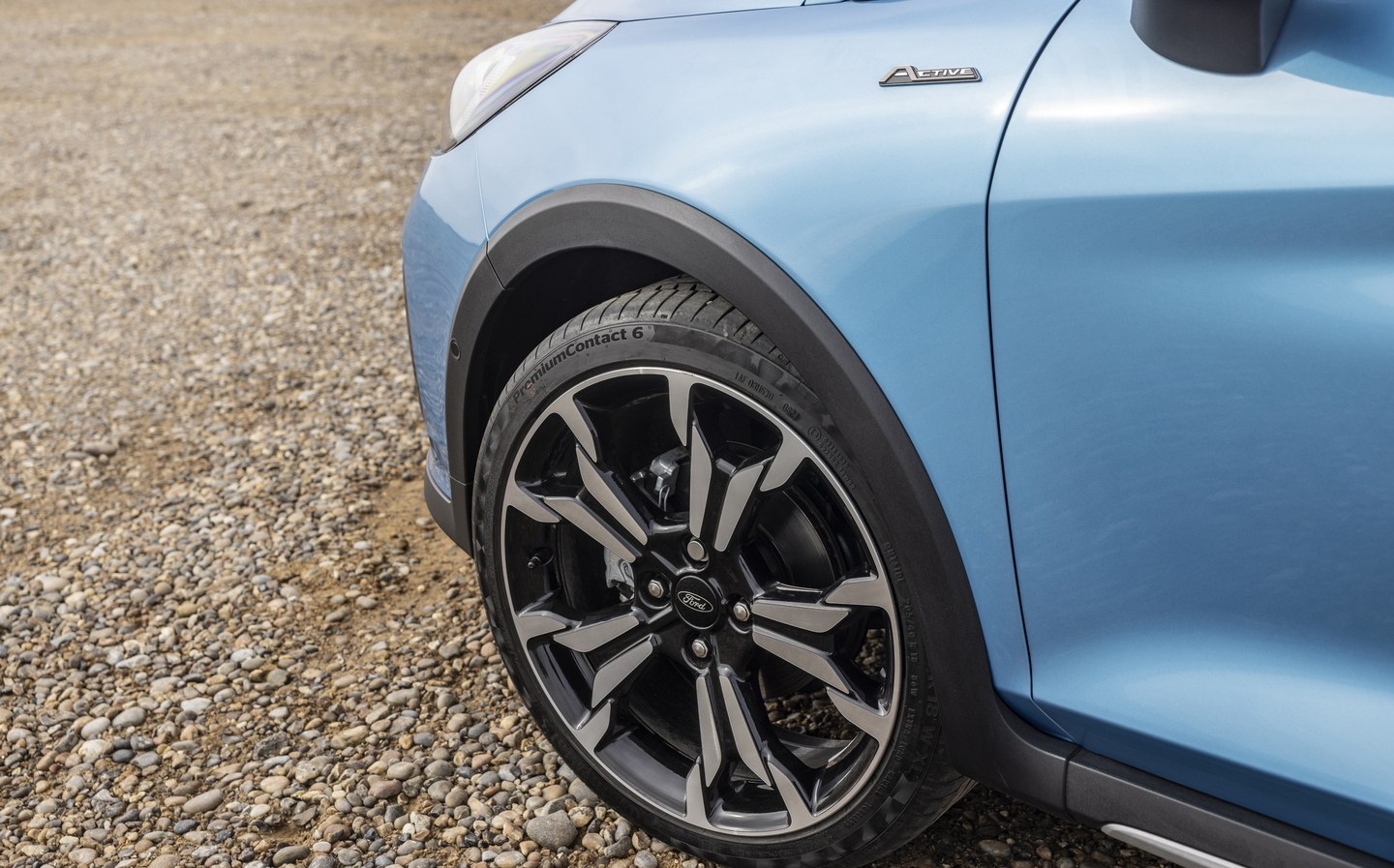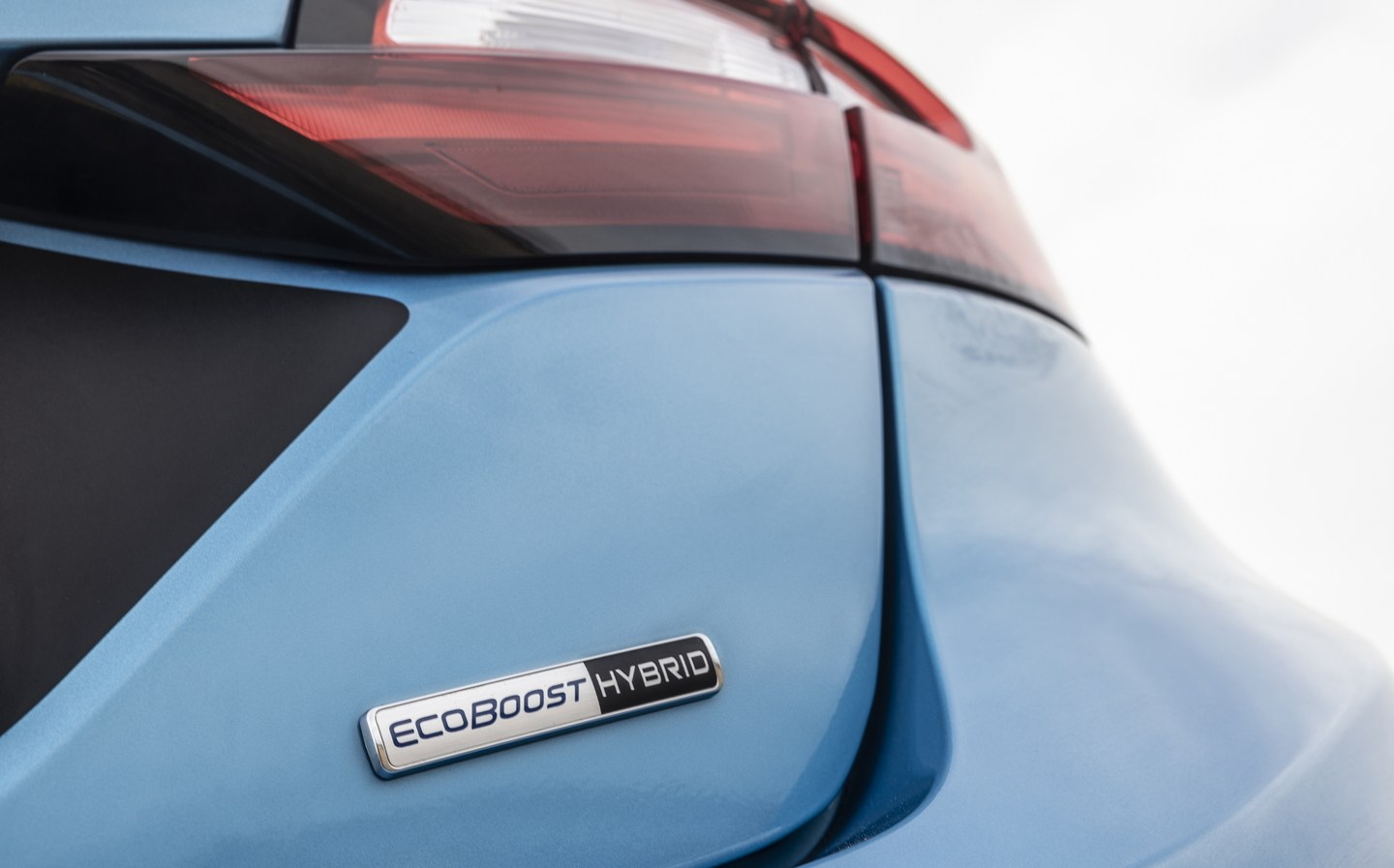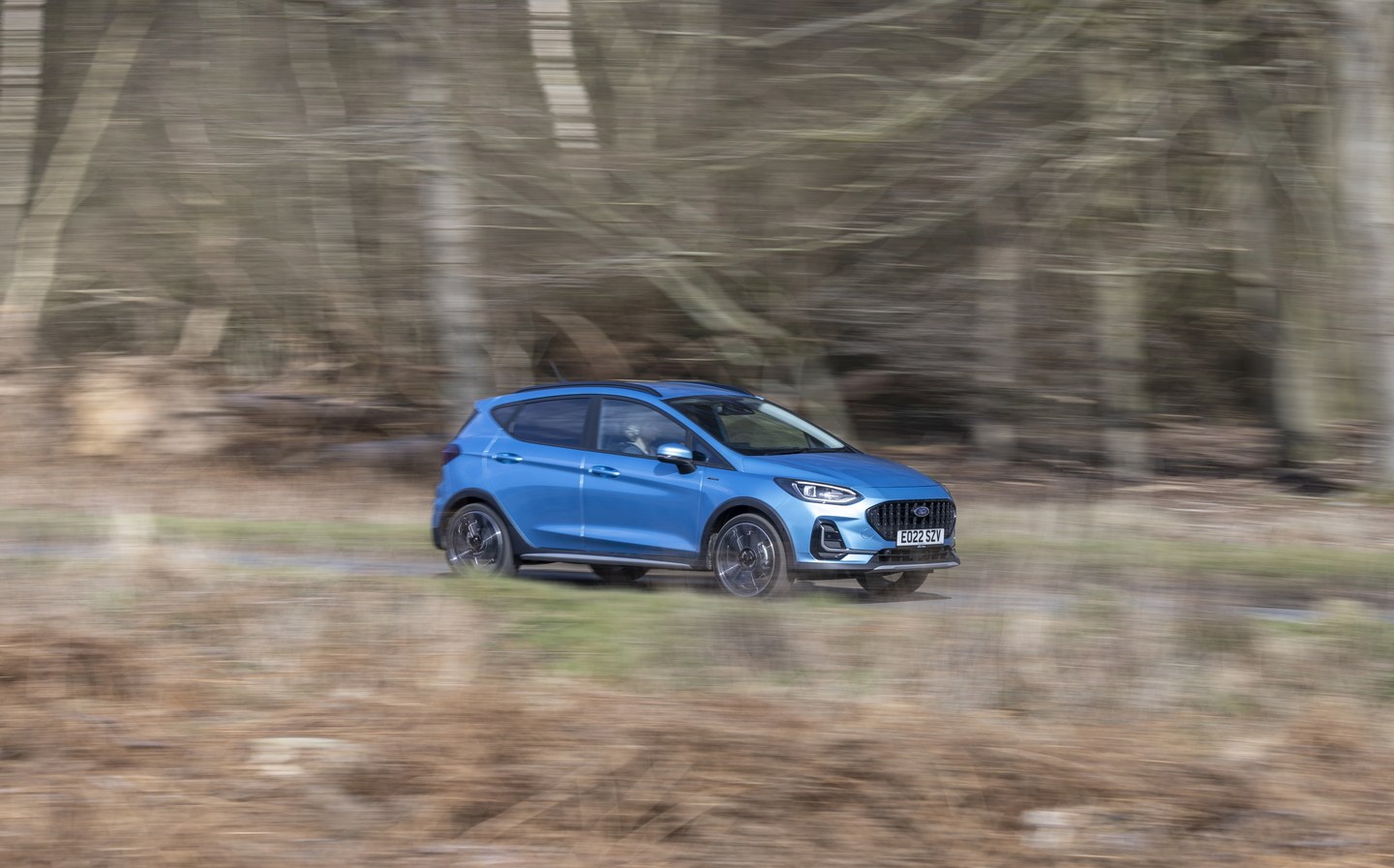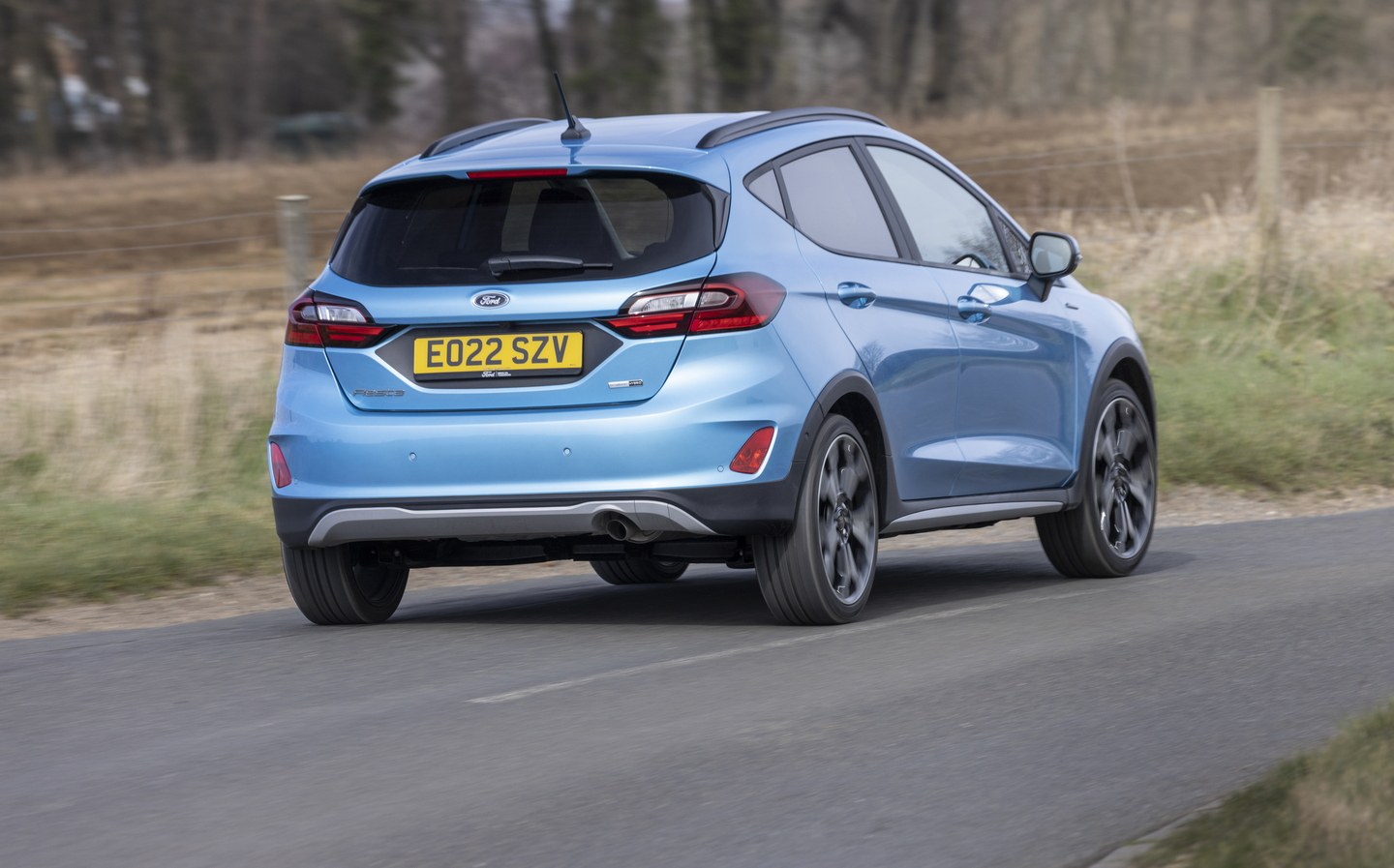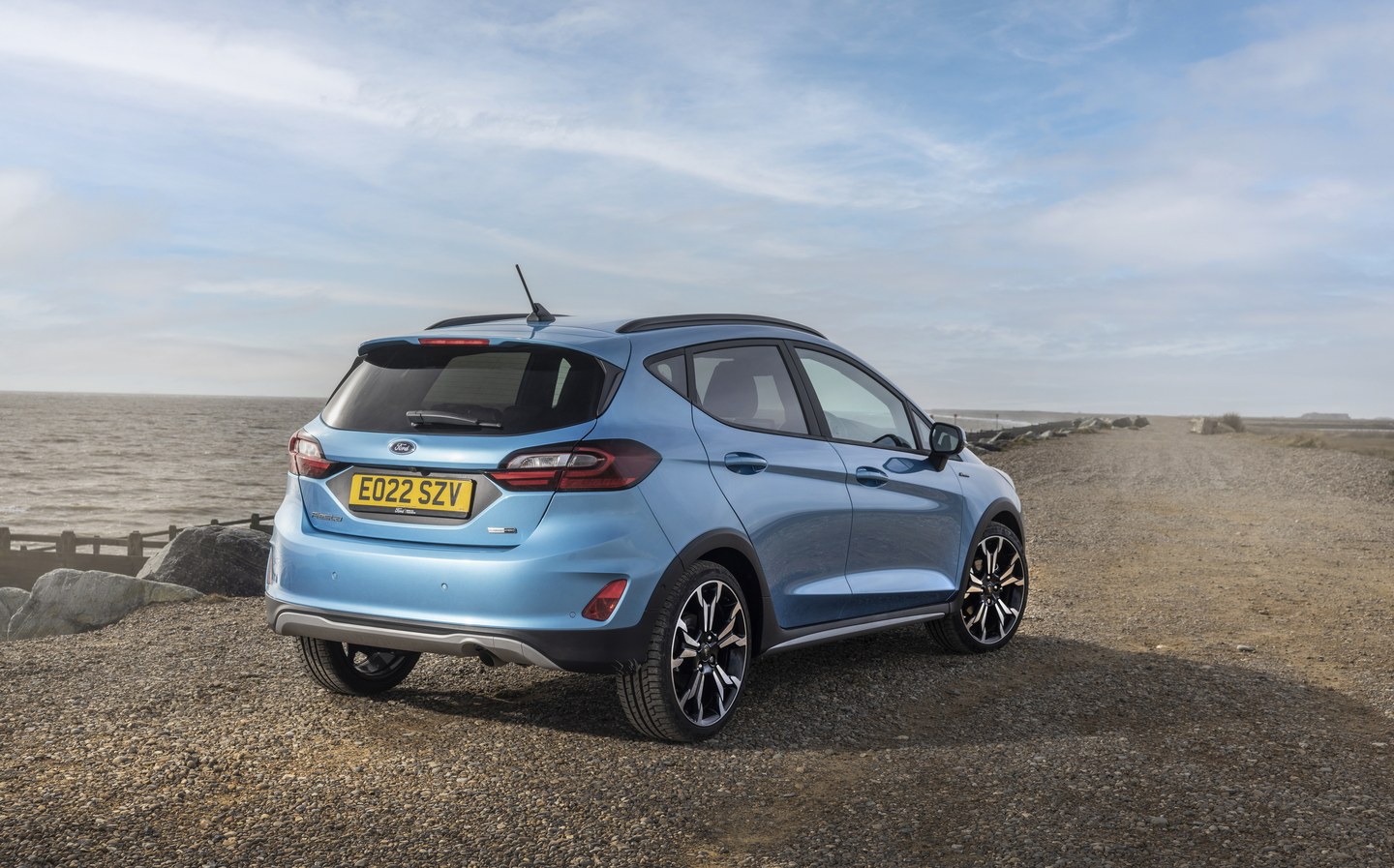Ford Fiesta Active 2022 review: Evolution trumps revolution
The Fiesta’s upgrades are minor, but who cares when the baseline was already so good?
Through no fault of its own, the Ford Fiesta has had a troubled few years. There was a time when the Fiesta topped UK sales charts and was consistently rated the best small hatchback on the market. Then there was a global pandemic. Supply shortages led Ford to prioritise more profitable models, namely the Transit van, Puma and Kuga, and Fiesta sales dwindled. Not through lack of demand, but a lack of supply.
Despite that, Ford has revealed a new-look Fiesta, mildly updated with a restyled front end and some new technology in a bid to keep the car fresh. In truth, the changes are very subtle, but let’s not forget this car was already one of the best in its class. The question is, can such minor updates keep it ahead of the chasing pack?

To find out, we tried the high-riding, SUV-inspired Active model (pictured centre), which hasn’t always been the best exponent of the Fiesta’s virtues. But it has the same tech and interior, and if this raised version of the Fiesta can still cut the mustard, the rest of the range should be pretty good.
Exterior design and rivals

From most angles, buyers will struggle to spot the difference between the new Fiesta and its predecessor, but it is obvious from the front. As with the updated Focus, Ford has fitted a brand new grille with a floating Ford logo in the centre, as part of a bid to bring the Fiesta up to date.
Keen-eyed readers might also spot changes to the bonnet and new lights, as well as new paint options, but otherwise it’s much as it was before.

There’s nothing wrong with the Fiesta’s styling – we think it’s quite attractive – but the new grille won’t be to every buyer’s taste. The old one looked classier, somehow.
Even so, the Fiesta looks and feels as modern as its key rivals: the Vauxhall Corsa and Toyota Yaris. And this Active model comes with a hint of off-road adventure that’s missing from many other small hatchbacks, thanks to its raised ride height and chunky cladding.
Those tweaks don’t bring any mechanical updates with them – there’s no all-wheel-drive option, for example – but the Active does look more able to take on a potholed track.
Interior and practicality
As with the exterior, Ford’s internal tweaks have been minor at best. There’s a new digital infotainment system for high-end models (more on that later), but that’s pretty much it for changes.
Even the new Sync4 infotainment system now fitted to the larger Focus has been ignored, with the Fiesta maintaining the old 8in Sync3 system.

That said, the Fiesta’s interior still feels fairly upmarket when compared with rivals. Both cabins feature some suspect plastics, but that’s much more acceptable among smaller models, where profit margins are tight. And although there are some naff materials lower down in the Fiesta’s interior, the overall impression is one of solidity and modernity.
The design still feels fresh, particularly with the digital instrument cluster, and everything fits together nicely. It’s more cohesive than in a Vauxhall Corsa’s cabin.
A longstanding issue with the Fiesta interior, however, is one of room. Cabin space isn’t bad, particularly in the front, and there shouldn’t be any problem carrying four adults as long as the journey isn’t too lengthy.
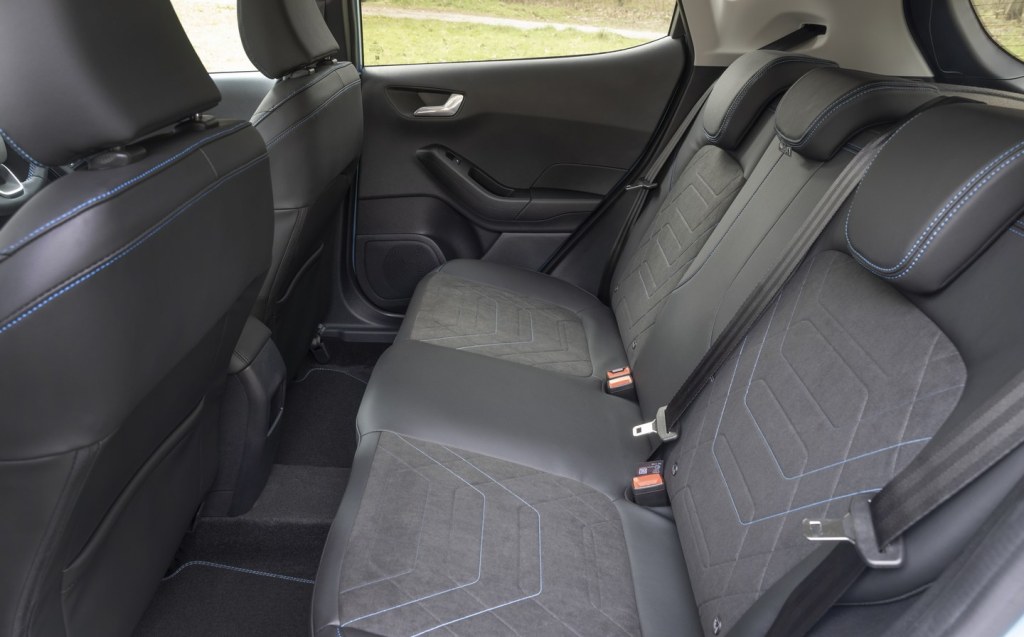
Boot space is less impressive, though, especially considering the amount of room now found in the back of the Volkswagen Polo and Seat Ibiza. Both those cars have more than 350 litres of luggage capacity – roughly 40 litres more than in the Fiesta.
Admittedly, a 40-litre difference isn’t massive, but it’s noticeable, and the two Volkswagen Group cars are slightly more practical than their arch rival.
That said, the Fiesta has marginally more room on board than the Vauxhall Corsa and the Toyota Yaris.
Technology and safety
While the Fiesta’s cabin remains largely unchanged, there is one new feature that makes quite a difference. It’s the new digital instrument display, which is fitted as standard on the top-end Vignale versions of the Titanium, Active and ST-Line models.
Finished in Ford’s traditional blue, it isn’t quite as clever as the systems fitted to the Volkswagen Group cars, including the VW Polo, Skoda Fabia and Seat Ibiza, but it’s clearer and more useful than that of the Toyota Yaris.

In essence, it presents all the usual information as you would expect but there’s an intuitive menu system that allows you to cycle through different displays, depending on what you need to see. While the VW Group systems are bigger and more customisable, the Ford screen remains clear and easy to use, which is all most customers will really want.
Perhaps more remarkable is Ford’s decision not to use the latest-generation Sync4 infotainment system in the new Fiesta. The system is already in service in the Focus and Mustang Mach-E, but Ford has retained the old Sync3 unit in its supermini.
Admittedly, Sync3 is still a solid and easy-to-use system, but the more modern Sync4 unit would have given the Fiesta a real boost.

Almost as a consolation prize, Ford has given the Fiesta some new safety tech. There’s something called Wrong Way Alert, which is designed to tell drivers when they’re heading the wrong way on a motorway or dual carriageway slip road, and Local Hazard Information, which relays hazard data to the cloud, allowing connected-car systems to warn other drivers.
Performance, power output and acceleration
If you thought the Fiesta’s external updates were minor, they’ve got nothing on the mechanical changes.
Ford has more or less left the Fiesta’s engine range alone, offering customers a selection of small petrol engines to choose from. There’s a 1.1-litre engine with 74bhp, although that’s only available in basic Trend form, but the majority are 1-litre EcoBoost options, some of which come with fuel-saving mild-hybrid technology.

The pick of the range is the engine we tested: the 1-litre EcoBoost 125 Hybrid, which comes with 123bhp and a choice of six-speed manual or seven-speed automatic gearboxes. We’d stick with the manual, partly because the automatic has a negative impact on economy and partly because Ford’s manual gearboxes are so good.
Even with the automatic gearbox and the Active accoutrements, the Fiesta remains impressively economical. This mid-range engine allows the car to achieve more than 50mpg on a long run, even with the automatic gearbox, and the manual manages a couple of miles more for every gallon it uses.
In fairness, though, every engine in the range is capable of similar economy, apart from the 1.5-litre unit in the go-faster ST model.

There are, however, discrepancies in performance. The 1.1-litre engine’s 74bhp is only enough for a glacial 14.7-second sprint from 0-62mph, while the 99bhp EcoBoost 100 engine cuts that time to a more respectable 10.8 seconds.
The 125 Hybrid’s 9.4-second 0-62mph time is even more competitive, but those who want more performance will find the 153bhp 155 Hybrid improves that further still.
Naturally, the 197bhp Fiesta ST is the fastest, getting from 0-62mph in 6.5 seconds before hitting a top speed of 143mph.
Ride and handling
Ford’s Focus Active and Fiesta Active, with their raised ride height and chunky body kits, are not always the best demonstrators of the cars’ talents.
However, there’s a train of thought that suggests because the Active models are the most compromised versions, they are the best indicator of the car’s latent ability. Put simply, if the Active model is good, the rest of the range should be great.

And in the case of the Fiesta, the Active model is very good indeed. Yes, it rolls quite a lot in corners, but then it would when it’s a couple of centimetres higher than the standard car and the centre of gravity has risen as a result. Even so, the Fiesta Active has plenty of grip and, though the steering doesn’t have too much feel, it’s still sharp and engaging. If you want a hatchback that’s fun to drive, look no further.
It’s good around town, too, with compact dimensions and light steering that makes it easy to manoeuvre even in tight spaces.
The ride is a little jiggly at times, although that’s common among cars with shorter wheelbases (the distance been the front and rear axles) and we suspect the raised suspension doesn’t help. It does improve at higher speeds, though, and the car always feels planted and composed, even if the occasional bump does make its presence felt.
Refinement is relatively impressive, too, even if there’s still a bit of wind and road noise. Ford has obviously tried to suppress the worst of the sound, and it makes the Fiesta quite an easy car to drive long distances. It certainly isn’t as tiring on long journeys as some of its main rivals.

Pricing and on-sale date
The Fiesta should be available in a range of trims already, with prices starting at £18,655, but global semiconductor chip shortages and pandemic/ Ukraine-related supply chain issues, new factory orders are currently unavailable. Our best advice is to contact a dealer and get on their list for alerts.
If and when you can get hold of a new Fiesta, that entry-level Trend trim, which comes with a touchscreen infotainment system, heated windscreen and automatic headlights, but it makes do with steel wheels and manual air conditioning.
Most customers will prefer the more luxurious models, of which there are essentially three to choose from. Customers wanting a more conventional Fiesta can have the Titanium, while those seeking a sportier look get the ST-Line.
Prices for the more rugged Fiesta Active model are higher, of course, and if you want the Vignale version as tested here it will cost you £28,305 — nearly £10k more than the base Fiesta. All three versions of the Active come with alloy wheels, keyless start and navigation, but the Vignale pack adds things like automatic climate control, a digital instrument cluster and more upmarket upholstery.
The range is topped by the high-performance ST model with its 200hp engine and motorsport-inspired equipment.

Verdict: Ford Fiesta Active review
The Ford Fiesta hasn’t changed much, but we aren’t complaining. Yes, it would have been nice to see improvements in cabin quality and the very latest touchscreen system, but that’s nit-picking really. Profit margins are tight in this part of the new car market, and the Fiesta’s cabin remains more attractive than that of the Vauxhall Corsa and the Toyota Yaris.
The real draw of the Fiesta has always been the way it drives, with the ability to ride well and handle brilliantly, while still being punchy and efficient. What’s even more impressive is that the Fiesta can do all that while wearing the Active accoutrements of raised suspension and tough-looking cladding. This car should be compromised, but it rises above all that.
However, as the Fiesta Active offers no real improvement in off-road capability, we’d recommend sticking with more conventional models unless you really need that ride height. Still, the Fiesta Active remains a front-runner in the small hatchback class.
Related articles
- After reading our review of the Ford Fiesta Active, you might like to read about the updated Ford Focus
- Or check out the UK’s top 10 most popular models
- If you’re interested in new cars, check out the most exciting cars coming in 2022
Latest articles
- Aston Martin Valkyrie AMR-LMH hypercar hits track ahead of 2025 Le Mans challenge
- Porsche has begun testing the electric Cayenne
- Cupra Leon 272 eHybrid 2024 review: Bigger battery, better tech … but is it a Cupra?
- Porsche 911 GTS 2024 review: Hybrid heresy or more Stuttgart genius?
- Extended test: 2023 Vauxhall Astra Sports Tourer GS PHEV
- Ford Capri revival has faced a lot of flak… but are buyers put off? Here’s what visitors to the Festival of Speed had to say
- F1 2024 calendar and race reports: What time the next grand prix starts and what happened in the previous rounds
- ‘No timeframe’ for how long Volvo’s returning estate cars will be on sale in UK
- Kia Picanto 2024 review: Updates add spice to cute Korean city car













